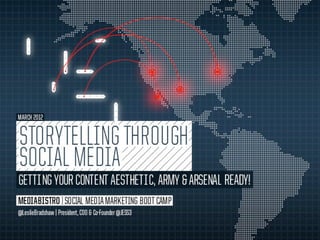
The Practitioner's Guide to Creating Content Like a Publisher
- 4. We’re all journalists now. Scott Gant, 2007 We're All Journalists Now: The Transformation of the Press and Reshaping of the Law in the Internet Age
- 5. Brands are media companies now. Commonly Said, 2011 - 2012 See especially: Red Bull, Intel and American Express
- 7. We’re all publishing companies now. Takes the concept of journalism And adds process, volume and scale
- 8. The devil is in the details. Brands aren’t set up to be publishers. They don’t necessarily understand the editorial process or have the stomach for the length of time it takes to build an audience. Josh Sternberg, Digiday January 25, 2012
- 9. Today and throughout the Mediabistro Social Media Boot Camp experience, we are going to help you overcome these challenges.
- 13. We've gone from being exposed to about 500 brand messages a day back in the 1970s to as many as 5,000 a day today. Jay Walker-Smith Yankelovich Consumer Research
- 14. See: 5,000 Engage: 76 Recall: 12 Act on: 5 Yankelovich Consumer Research
- 15. See: 5,000 you Engage: 76 have to Recall: 12 be the Act on: 5 0.1% Yankelovich Consumer Research
- 16. You have to create breakthrough content to be noticed.
- 17. How? Follow the right processes and formulae.
- 21. edgy star power humor by: 72 and sunny for: K-Swiss
- 22. mocumentary zeitgeist humor by: john st. for: themselves
- 23. You have to create work that provides value to be shared.
- 24. informative star power timely by: JESS3 for: Wikipedia’s 10th Anniversary
- 25. social media pros giving pragmatic insights visualized in a “Mad Men Yourself” style Eloqua - The Social Media ProBook http://jess3.com/the-social-media-probook/
- 26. the growth of the internet and social media’s role visualized in a 5 minute video The State of the Internet http://jess3.com/the-state-of-the-internet/
- 27. 150 page white paper by The Economist visualized in a 6 minute video Animated Study on Women’s Economic Opportunity for The Economist http://jess3.com/womens-economic-opportunity-index/
- 28. ICANN’s new TLDs vs. the “old” TLDs told through a decaying city / burgeoning city paradox Washington Post - The Future of Domains http://jess3.com/the-future-of-domains-icannlove/
- 29. Creating compelling content has become a necessity for brands.
- 30. how TV ratings work told through puppets and papercraft told through a behind the scenes TV Ratings 101 for ESPN (Puppets & Papercraft) http://jess3.com/espn-tv-ratings-101/
- 31. Gmail’s fidelity from web to mobile told through papercraft and stop motion animation told through a behind the scenes Stop Motion Animation for Gmail http://jess3.com/gmail-stop-motion-animation-video/
- 32. Creating content for brands is a delicate balance between business objectives, creativity & user goals.
- 35. The only important thing about design is how it relates to people. Victor Papanek Design for the Real World: Human Ecology and Social Change (1971)
- 40. Top 5 reasons building an arsenal of templates makes sense for you: 1. Scaleable resource. 2. Able to deploy quickly and efficiently. 3. Socially snackable; will show up as social graph share images and can be re-purposed by others, while retaining your stamp. 4. Enhances editorial content, reinforcing its thesis, supporting data and overall argument. 5. Smart media brands rely heavily on editorial templates. Brands like Bloomberg, The Economist and WSJ have set the standard for smart, branded assets that accompany their editorial. Follow their lead.
- 41. Overview of how the graphics are integrated with their editorial. These "spreads" are heralded as some of the best because of their attention to editorial design.
- 42. The layout and information flow is interesting and unique, while still ensuring that the colors and textures are distinctly Bloomberg BusinessWeek.
- 43. Lists and tables of contents don't have to be relegated to text; Bloomberg BusinessWeek shows us that visual design can help spice up any information (and layout!).
- 44. Data-driven design is a part of Bloomberg's overall style. It is smart, trendy and modern. Consider levering this for your own brand.
- 45. Notice how the red in the lefthand corner ties it to The Economist's brand. Copy, colors and fonts also consistent with their publication. How do you want to leave your (water)mark?
- 46. More complex chart graphics, but still on brand. Creates "snackable" assets for The Economist to share in social and retain credit.
- 52. Big Data: The Next Frontier for Innovation, Competition and Productivity http://www.mckinsey.com/mgi/publications/big_data/pdfs/MGI_big_data_full_report.pdf New Ways to Exploit Raw Data May Bring Surge of Innovation, a Study Says http://www.nytimes.com/2011/05/13/technology/13data.html?_r=2 For Today’s Graduate, Just One Word: Statistics http://www.nytimes.com/2009/08/06/technology/06stats.html Creative Internet by Google Creative Labs http://bit.ly/creativeinternet Have You Restructured for Global Success? http://hbr.org/2011/10/have-you-restructured-for-global-success/ar/1 How Much Data Will Humans Create & Store This Year? [INFOGRAPHIC] http://mashable.com/2011/06/28/data-infographic/ FFunction - What is Data Visualization http://blog.ffctn.com/what-is-data-visualization Hal Varian on how the Web challenges managers http://www.mckinseyquarterly.com/Hal_Varian_on_how_the_Web_challenges_managers_2286 Eric Schmidt: Every 2 Days We Create As Much Information As We Did Up To 2003 http://techcrunch.com/2010/08/04/schmidt-data/
Editor's Notes
- \n
- \n
- \n
- \n
- \n
- \n
- \n
- \n
- \n
- \n
- \n
- \n
- \n
- \n
- \n
- \n
- \n
- \n
- \n
- \n
- \n
- \n
- \n
- \n
- \n
- \n
- \n
- \n
- \n
- \n
- \n
- \n
- \n
- \n
- \n
- \n
- \n
- \n
- \n
- \n
- \n
- \n
- \n
- \n
- \n
- \n
- \n
- \n
- \n
- \n
- \n
- \n
